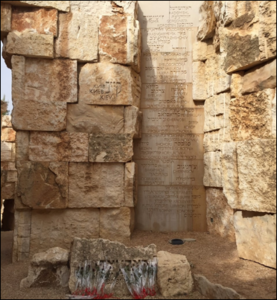Hello dear Kolot Mayim friends,
Another week draws us closer to Rosh Hashanah. This week we explore Ki Tavo – when you come near. Torah is speaking to us about k’lal Yisroel, the Israelite peoples entering the Land, but for us, today, Ki Tavo also carries the extra meaning of approaching our new year. What is coming ahead for us and what are we leaving behind? And what do we want to build?
In Ki Tavo, Chapter 27, we read that the Israelite elders issue a command to the people. When they arrive – finally – into the Land, they are to set up great stones, coat the stones with plaster and inscribe the stones with words of Torah. This command is repeated twice. Not only should the words of Torah be inscribed on these stones – but those words should be well-clarified and protected with an extra coating of plaster. What does this all mean?
Should the writing of Torah be (merely) clearly legible? Or, should there be some explanation of meanings attached to these commands? How could there be stones large enough for all these commands, to say nothing of explications of meaning? Rashi states that the words should be clear to anyone who reads them – as in all of the then 70 primary languages. Ibn Ezra opts for a clear and legible inscription. He adds that not all of Torah could be inscribed – just the basics if you will.
One thinks of Stonehenge, but with inscriptions. Torah is no longer just carried on stone tablets but on pillars, and still carved into stone. Imagine what a monument – of memory and of inspiration these pillars would have been to the people as they entered the Land, unsure of where they are headed, but holding fast to the words of what they have heard.
 I thought of the pillars at Yad VaShem, in the Valley of the Communities, built from large blocks of Jerusalem stone, inscribed with the names of over 5,000 Jewish villages and shtetls and towns, destroyed, their residents annihilated. The pillars in Yad VaShem stand in memory– and in defiance of destruction in the Land of Israel.
I thought of the pillars at Yad VaShem, in the Valley of the Communities, built from large blocks of Jerusalem stone, inscribed with the names of over 5,000 Jewish villages and shtetls and towns, destroyed, their residents annihilated. The pillars in Yad VaShem stand in memory– and in defiance of destruction in the Land of Israel.
The New Year is a time when we think back through the previous year – and often build a pillar of good intentions in our minds. We say to ourselves, when we are feeling a little doubtful – “it isn’t engraved in stone” but our elders wanted our commandments to be literally engraved in stone. Pillars, not so portable – for all to see. A Magna Carta, if you will engraved in stone, not inscribed in ink.
These days of Elul are a time to think about what might be engraved in stone for us today. And engraved on our hearts.
Kein yehi ratson,
Rabbi Lynn
Ki Tavo
August 31, 2020 by Rabbi Lynn Greenhough • From the Rabbi's Desk Tags: ki tavo •
Hello dear Kolot Mayim friends,
Another week draws us closer to Rosh Hashanah. This week we explore Ki Tavo – when you come near. Torah is speaking to us about k’lal Yisroel, the Israelite peoples entering the Land, but for us, today, Ki Tavo also carries the extra meaning of approaching our new year. What is coming ahead for us and what are we leaving behind? And what do we want to build?
In Ki Tavo, Chapter 27, we read that the Israelite elders issue a command to the people. When they arrive – finally – into the Land, they are to set up great stones, coat the stones with plaster and inscribe the stones with words of Torah. This command is repeated twice. Not only should the words of Torah be inscribed on these stones – but those words should be well-clarified and protected with an extra coating of plaster. What does this all mean?
Should the writing of Torah be (merely) clearly legible? Or, should there be some explanation of meanings attached to these commands? How could there be stones large enough for all these commands, to say nothing of explications of meaning? Rashi states that the words should be clear to anyone who reads them – as in all of the then 70 primary languages. Ibn Ezra opts for a clear and legible inscription. He adds that not all of Torah could be inscribed – just the basics if you will.
One thinks of Stonehenge, but with inscriptions. Torah is no longer just carried on stone tablets but on pillars, and still carved into stone. Imagine what a monument – of memory and of inspiration these pillars would have been to the people as they entered the Land, unsure of where they are headed, but holding fast to the words of what they have heard.
The New Year is a time when we think back through the previous year – and often build a pillar of good intentions in our minds. We say to ourselves, when we are feeling a little doubtful – “it isn’t engraved in stone” but our elders wanted our commandments to be literally engraved in stone. Pillars, not so portable – for all to see. A Magna Carta, if you will engraved in stone, not inscribed in ink.
These days of Elul are a time to think about what might be engraved in stone for us today. And engraved on our hearts.
Kein yehi ratson,
Rabbi Lynn